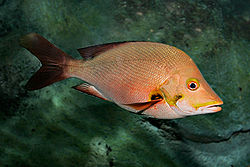| Lutjanidae Temporal range: | |
|---|---|
 | |
| Humpback red snapper, Lutjanus gibbus | |
| Scientific classification | |
| Kingdom: | Animalia |
| Phylum: | Chordata |
| Class: | Actinopterygii |
| Order: | Acanthuriformes |
| Family: | Lutjanidae T. N. Gill, 1861 [1] |
| Subfamilies | |
see text | |
Lutjanidae, the snappers and fusiliers, are a family of perciform fishes, mainly marine but with some members inhabiting estuaries and, in some cases, fresh water (e.g., Lutjanus goldiei ). The family includes about 113 species. Most species are used for food and many are of high economic importance. Many species around the world are known in local languages as red snapper, including species from different genera (including Lutjanus and Pristipomoides)
Contents
Snappers inhabit tropical, subtropical, and warm-temperate regions of all oceans. Some snappers grow up to about 1 m (3.3 ft) in length, and one species, the cubera snapper, grows up to 1.52 m (5 ft 0 in) in length. [2] Most are active carnivores, feeding on crustaceans or other fishes, [3] though a few are plankton-feeders. They can be kept in aquaria, but commonly grow too fast to be popular aquarium fish. Most species live at depths reaching 100 m (330 ft) near coral reefs, but some species are found up to 500 m (1,600 ft) deep. [3]

As with other fishes, some snapper species host parasites. A detailed study conducted in New Caledonia has shown that coral reef-associated snappers host about nine species of parasites per fish species. [4]












